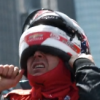They got the data from 11 crashes in the past (2 in the WEC, 9 in F1). As an example they also got the detailed analyses of Webbers crash last year in Sao Paulo

On the first datasheet they have all the data about the speed of the car, on which speed the driver lost the control of the car, with which speed he suffered the impact, how much time past between the control lost and the impact, which angle he had at the impact, etc. Furthermore on this sheet they also listed the Accelerations.

On this datasheet you can see on which direction of the car we had the Accelearation (red) and the loss of velocy (black).

This datasheet is a bit more detailed: On the left we have the acceleration in the moments of the impact (within 300 ms). On the right the velocy change in the moments of the impact. The graph below is shows how much the car got deflected after the impact.
AMuS also did an interview with FIA-accident-reasearcher Andy Mellor (google translate)
https://translate.go...or-9908331.html
Here are some more raw data about other crashes in the FIA database.
Mark Webber (Porsche/WEC/Interlagos 2014)
Lost of control: 245 kph
Impact: 185 kph
Angle: 28 degrees backwards
Deceleration: 98.2 g
Max Verstappen (Toro Rosso/F1/Monaco 2015)
Lost of control: 268 kph
Impact: 120 kph
Angle: 90 degrees frontal
Deceleration: 22.0 g
Felipe Massa (Ferrari/F1/Budapest 2009)
Lost of control: 259 kph
Impact: 104 kph
Angle: 60 degrees frontal
Deceleration: 21.5 g
Robert Kubica (BMW/F1/Montreal 2007)
Lost of control: 277 kph
Impact: 227 kph
Angle: 17 degrees frontal/sideways
Deceleration: 43.1 g
Jenson Button (BAR/F1/Monaco 2003)
Lost of control: 298 kph
Impact: 90 kph
Angle: 90 degrees sideways
Deceleration: 29.7 g
Takuma Sato (Jordan/F1/Spielberg 2002)
Lost of control: 0 kph
Impact: 56 kph
Angle: 90 degrees
Deceleration: 55.0 g
Sergio Perez (Sauber/F1/Monaco 2011)
Lost of control: 279 kph
Impact: 110 kph
Angle: 90 degrees sideways
Deceleration: 81.6 g
Luciano Burti (Prost/F1/Spa 2001)
Lost of control: 291 kph
Impact: 155 kph
Angle: 30 degrees forwards
Deceleration: 85.4 g
Kimi Räikkönen (Ferrari/F1/Silverstone 2014)
Lost of control: 239 kph
Impact: 172 kph
Angle: 20 degrees forwards
Deceleration: 54.9 g
Jules Bianchi (Marussia/F1/Suzuka 2014)
Lost of control: 213 kph
Impact: 126 kph
Angle: 55 degrees sideways
Deceleration: 58.8 g
Allan Simonsen (Aston Martin/GT/Le Mans 2013)
Lost of control: 122 kph
Impact: 78 kph
Angle: 38 degrees sideways/backwards
Deceleration: not recorded
What action were taken to improve the safety of F1
- 1975 NEW: headrest in the cockpit, fire extinguisher on board
- 1976 NEW: Feet driver behind front axle, rollbar front wheel
- 1984 NEW: Crash Test forward 10 m / s
- 1985 Crash Test forward 10 m / s -> 11 m / s, NEW: Side 5 m / s
- 1988 NEW: Static load test cockpit, Tank
- 1989 NEW: Cockpit 50.8 cm (height). 60 cm (length), 45 cm (width)
- 1993 NEW: stress test rollbar 5.8 t (vertical)
- 1995 Crash Test forward 11 m / s -> 12 m / s, NEW: Hatchback 5 m / s, Cockpit 55cm (height), 65 cm (length), 45 cm (width)
- In 1996 new: 75 mm neck protection, headrest 2500 mm, 22 cm below the cockpit roll bar line (height), 77.5 cm (length), 52 cm (width), accident recorder
- 1997 Crash Test tail 5 m / s -> 12 m / s, NEW: compressible steering column
- 1998 Crash Test side 5 m / s -> 7 m / s, NEW: cockpit footwell: 45 * 35 cm
- 1999 Crash Test forward 12 m / s -> 13 m / s, helmet 70 cm below line roll bar, NEW: Depending 1 wheel rope 5 t, seat removeable with driver
- 2000 Crash Test forward 13 m / s -> 14 m / s, load test rollbar 6.0 t (vertical), 4.5 t (longitudinal), 2.4 t (side) NEW: Static load test: nose, footwell, seat, tank, chassis thickness: 3.5 mm (incl. Kevlar layer)
- 2001 Crash Test Side 7 m / s -> 10 m / s, Cockpit 850 cm (length), rollbar 9.0 t (vertical), 6.0 t (longitudinal), 5.0 t (side) footwell padding 25 mm
- 2002 2 wheel ropes 5 t, NEW: Crash surface side: 45 * 55 cm
- 2003 Crash Test forward 14 m / s -> 15 m / s, NEW: provision HANS
- 2006 Crash Test rear 12 m / s -> 15 m / s
- 2007 Crash Test rear 15 m / s -> 12 m / s, crash area behind 10 * 13 cm, NEW: chassis flank with cyclon to 55 cm height
- 2008 Headrest size 3300 mm², cockpit walls 5 cm higher
- 2010 5 cm cyclon for Helmets
- 2011 chassis base with cyclon
- 2013 Crash test standards for testing
- 2014 standard crash structure side: 2 pins à 12 cm, 50 cm in front of the cockpit rear wall
- 2015 Complete chassis with cyclon
https://translate.go...ew-9908404.html
Source
http://www.auto-moto...hs-9908318.html
http://www.auto-moto...er-9908395.html
Edited by Marklar, 13 August 2015 - 12:01.



















